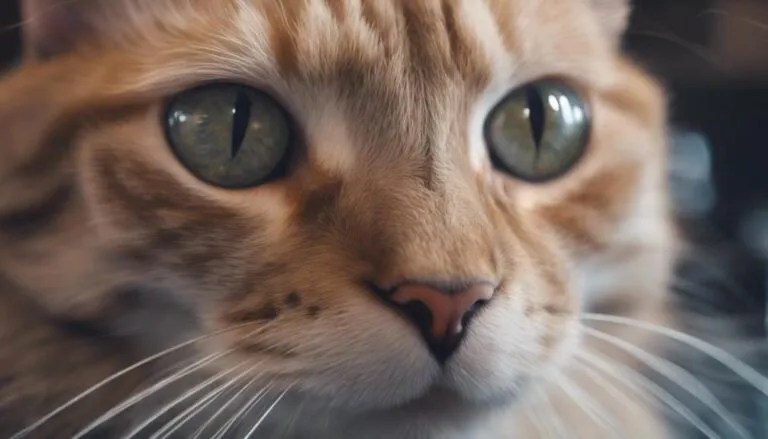The Best Fluffy Pancakes recipe you will fall in love with. Full of tips and tricks to help you make the best pancakes.

The enigmatic behavior of cats bringing socks to their owners has captivated both feline enthusiasts and researchers for years. This peculiar ritual, observed in both domesticated and wild cats, has sparked numerous theories about its origins and significance.
From teaching hunting skills to playful interactions, the motivations behind feline sock delivery are varied and intriguing.
In this article, we explore the fascinating world of cats and their innate hunting instincts, shedding light on the factors that influence this mysterious behavior.
So, join us as we embark on a journey to uncover the secrets behind feline sock delivery and gain a deeper understanding of our feline companions.
Key Takeaways
- Cats bring socks to their owners as a way to teach hunting skills, mimicking their natural instinct to bring prey to their young.
- This behavior is more commonly observed in female cats, especially spayed ones, but can also be seen in male cats.
- Some cats bring socks as part of a game, similar to playing fetch, and certain cat breeds may be more prone to this behavior.
- It is generally harmless for cats to carry socks, as long as they are not trying to eat them. However, if a cat shows signs of eating non-food items, it may indicate a rare condition called feline pica.
Cats Teaching Hunting Skills
Cats exhibit the behavior of bringing socks to their owners as a means of teaching hunting skills. This behavior is influenced by the role of prey availability and the impact of the indoor vs outdoor environment.
In the wild, mother cats teach their young how to eat by bringing home prey. However, indoor cats without access to live prey may use socks as a substitute. The natural hunting instinct drives this behavior, as cats carry prey-like objects in their mouths as a reflection of their hunting behavior.
Cats may feel like they have captured their next meal when carrying socks, which can be entertaining and stimulating for them. It is important to note that this behavior is not exclusive to female cats and can be seen in both males and females.
Feline Retrievers
Feline retrievers, often observed in certain cat breeds such as Siamese cats, engage in the behavior of bringing socks as part of a game, similar to playing fetch. However, socks are not the only objects that cats may retrieve. Other common items include small toys, balls, and even paper balls.
This behavior stems from a cat's instinctual drive to hunt and capture prey. While some cats naturally exhibit this behavior, it is also possible to train cats to retrieve specific items through positive reinforcement techniques. By rewarding cats with treats or praise when they bring back the desired object, they can learn to associate the behavior with a positive outcome.
With patience and consistency, cats can become skilled retrievers, providing both mental stimulation and entertainment for their owners.
Fun and Play
The playful nature of cats extends beyond their instinctual drive to retrieve objects, such as socks, as part of a hunting game. Cats engage in interactive play with sock toys in a manner that mirrors their natural hunting behavior.
Carrying socks around can be entertaining and stimulating for cats, as they view them as prey-like objects. This behavior is driven by their evolutionary history and innate instincts. Providing cats with sock toys can satisfy their desire for interactive play and mimic the experience of hunting.
Not Maternal Instinct
Contrary to popular belief, the behavior of cats bringing socks is not indicative of maternal instincts. This theory is not supported by evidence, as the behavior is not exclusive to female cats.
A survey conducted on cats exhibiting this behavior found an equal split between male and female cats. Maternal instincts are more likely to be displayed when cats bring their actual kittens.
The act of bringing socks is driven by the cat's natural hunting instinct and evolutionary history, rather than any maternal instincts. Therefore, it is important to understand that when cats bring socks, they are engaging in a form of play, fulfilling their natural hunting instincts, and not displaying any maternal behavior.
No Need to Worry
After debunking the theory of maternal instincts, it is important to address any concerns that may arise from the behavior of cats bringing socks. Rest assured, there is generally no need to worry when it comes to cats carrying socks. Here are a few key points to consider:
- Harmlessness of the Behavior:
- Cats carrying socks is generally harmless.
- As long as cats are not trying to eat the socks, there is no cause for concern.
- Cats may enjoy retrieving socks but not necessarily consuming them.
- Dangers of Feline Pica:
- Eating non-food items may indicate a rare condition called feline pica.
- Nursing on socks, especially wool ones, is unusual but usually not harmful unless ingestion occurs.
- If you notice excessive sock chewing or ingestion, it is recommended to consult a veterinarian.
Natural Instincts and Behavior
Cats' natural instincts and behaviors play a significant role in their fascination with bringing socks to their owners.
This behavior can be attributed to their feline hunting behavior and predatory instincts. Cats, as natural hunters, have an innate drive to catch and kill prey.
Bringing socks to their owners may serve as a substitute for live prey, as indoor cats often lack access to such stimuli.
Additionally, cats may view the act of retrieving socks as a form of play and entertainment, reflecting their evolutionary history as skilled hunters.
Certain cat breeds, such as Siamese cats, may be more prone to exhibiting this behavior.
Factors Influencing Sock Delivery
Factors influencing sock delivery in cats can vary based on individual characteristics and environmental factors. Understanding these factors can help cat owners better comprehend and manage this behavior.
- Feline sock preferences:
- Cats may have specific preferences for certain types of socks, such as those with a particular texture or scent.
- Some cats may prefer socks that resemble prey, such as ones with feathers or fur-like material attached.
- Individual cats may also have personal preferences based on their past experiences or instincts.
- Training techniques:
- Positive reinforcement training can be effective in encouraging cats to retrieve socks.
- Rewarding cats with treats or praise when they bring a sock can reinforce the behavior.
- Consistency and patience are key when implementing training techniques.
- Environmental factors:
- Cats may be more likely to engage in sock delivery behavior in households with limited environmental enrichment.
- Providing cats with stimulating toys and activities can help redirect their hunting instincts away from socks.
- Maintaining a clean and organized living space can reduce the availability of socks as potential prey.
Tips for Encouraging Sock Retrieval
To encourage sock retrieval behavior in cats, it is important to implement positive reinforcement techniques and provide appropriate environmental enrichment.
Training techniques can be used to teach cats to retrieve socks, similar to how dogs are trained to fetch objects. Start by associating the sock with a reward, such as a treat or praise, and gradually increase the difficulty by placing the sock farther away. Reward systems should be consistent and immediate to reinforce the desired behavior.
Additionally, providing environmental enrichment can stimulate a cat's natural hunting instincts and encourage sock retrieval. This can be achieved by offering interactive toys, puzzle feeders, and play sessions that mimic hunting scenarios.
Frequently Asked Questions
Can All Cats Learn to Bring Socks as Part of a Hunting Ritual?
Training techniques for teaching cats to retrieve specific objects vary, but not all cats will learn to bring socks as part of a hunting ritual. The behavior is driven by natural instincts and can be influenced by breed and individual personality.
Do Cats Only Bring Socks, or Do They Bring Other Items as Well?
Cats commonly bring various items as gifts to their owners, including toys, feathers, and small prey-like objects. The desire to bring items stems from their natural hunting instincts and can be seen as a form of play and bonding.
How Can I Encourage My Cat to Bring Socks as Part of a Game?
To encourage your cat to bring socks as part of a game, try incorporating interactive play sessions using sock-like toys. Use positive reinforcement, such as treats and praise, to reward your cat for successfully retrieving and returning the sock. This activity can provide mental and physical stimulation, strengthen the bond between you and your cat, and tap into their natural hunting instincts.
Are There Any Health Risks Associated With Cats Carrying Socks?
Potential health risks associated with cats carrying socks include the risk of ingestion, which can lead to gastrointestinal obstruction or choking. To prevent sock swallowing, ensure socks are securely stored away and monitor your cat's playtime with socks.
Are There Any Specific Cat Breeds That Are More Likely to Engage in Sock Retrieval Behavior?
Certain cat breeds, such as Siamese cats, are more likely to engage in sock retrieval behavior. This suggests that genetic factors may play a role in this particular hunting ritual exhibited by cats.
Conclusion
In conclusion, the behavior of feline sock delivery is a fascinating display of cats' hunting instincts and their playful nature. While it may not be a sign of maternal behavior, it serves as a way for cats to teach their owners how to hunt and engage in a playful game.
However, it is important for cat owners to be aware of the potential risks associated with this behavior, such as feline pica.
Understanding the underlying motivations and factors can help cat owners better appreciate and manage this intriguing ritual.








